Trade Finance and Investment: An International Perspective on UK
VerifiedAdded on 2023/06/16
|13
|4138
|256
Report
AI Summary
This report provides an overview of international trade finance and investment, with a specific focus on the UK economy. It begins with a background study of financial markets, tracing their history and evolution, and then delves into capital allocation within the domestic UK economy, particularly in Sterling Securities, noting a decline in net investment due to factors like BREXIT and COVID-19. The report further examines capital allocation in the international market, focusing on Foreign Direct Investment (FDI) trends in the UK, highlighting the impact of BREXIT on FDI inflows and the main investing countries and sectors. It also touches upon the challenges faced by the UK due to industrialization and trade policies. The report concludes by summarizing the key findings and their implications for the UK's economic outlook.
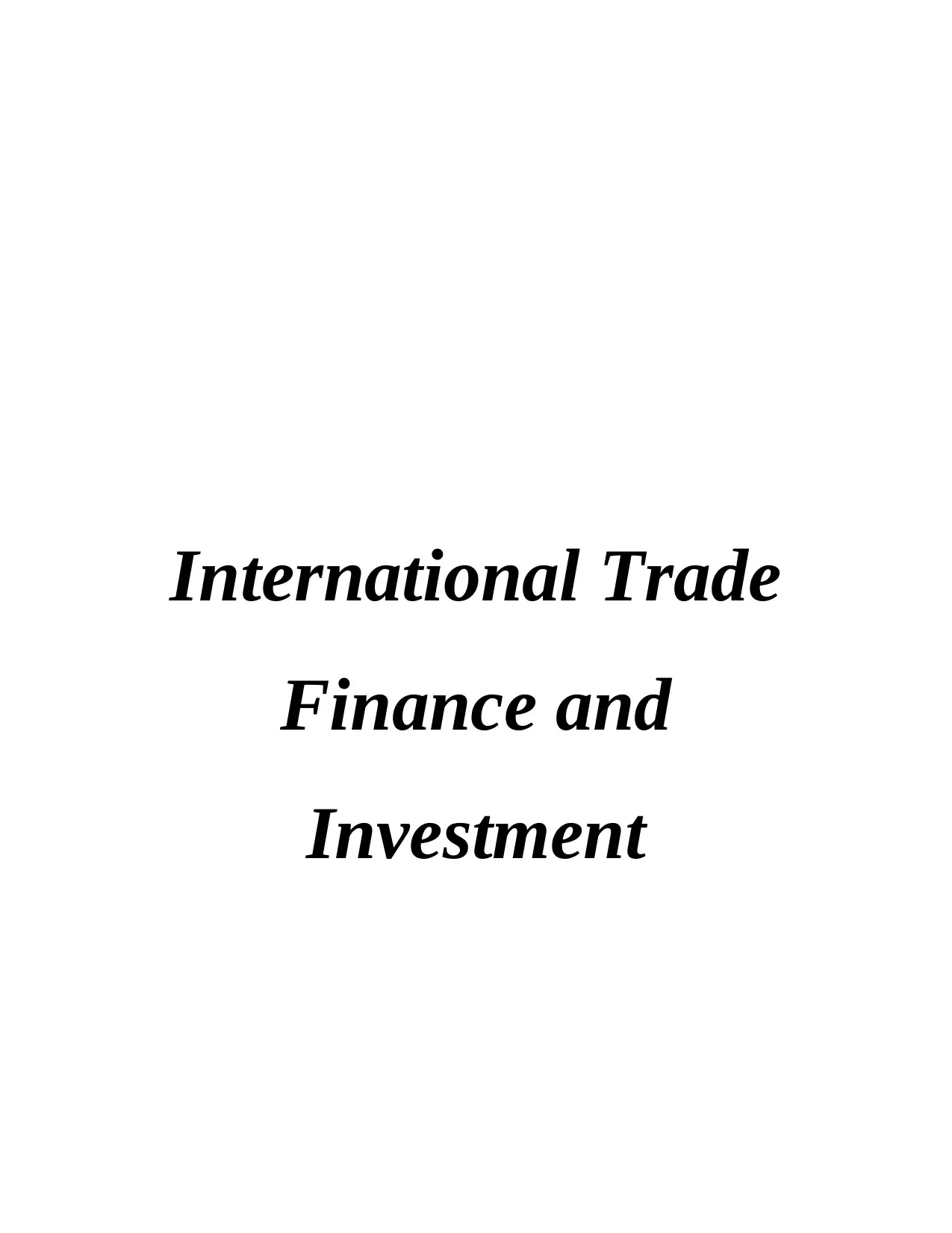
International Trade
Finance and
Investment
Finance and
Investment
Paraphrase This Document
Need a fresh take? Get an instant paraphrase of this document with our AI Paraphraser
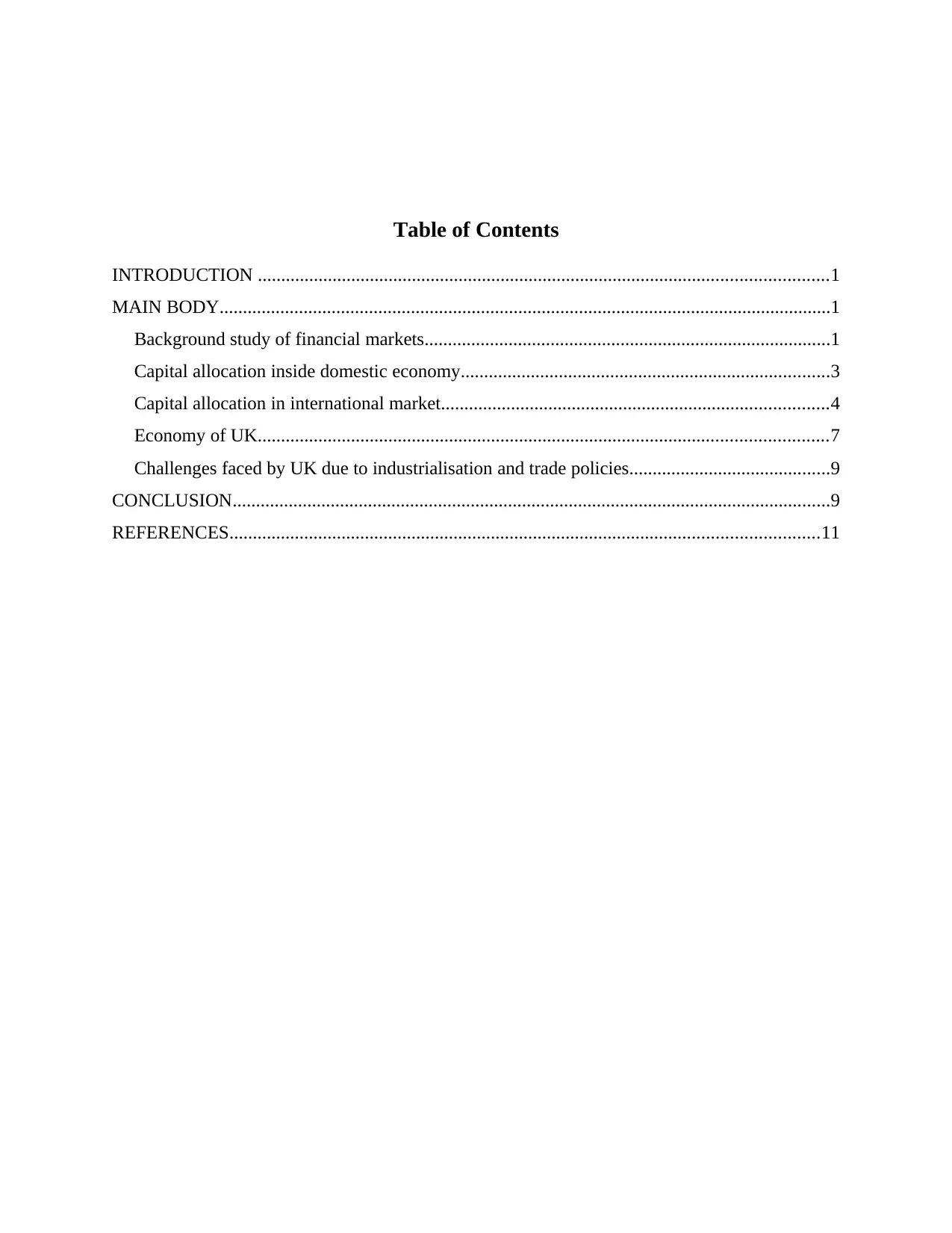
Table of Contents
INTRODUCTION ..........................................................................................................................1
MAIN BODY...................................................................................................................................1
Background study of financial markets.......................................................................................1
Capital allocation inside domestic economy...............................................................................3
Capital allocation in international market...................................................................................4
Economy of UK..........................................................................................................................7
Challenges faced by UK due to industrialisation and trade policies...........................................9
CONCLUSION................................................................................................................................9
REFERENCES..............................................................................................................................11
INTRODUCTION ..........................................................................................................................1
MAIN BODY...................................................................................................................................1
Background study of financial markets.......................................................................................1
Capital allocation inside domestic economy...............................................................................3
Capital allocation in international market...................................................................................4
Economy of UK..........................................................................................................................7
Challenges faced by UK due to industrialisation and trade policies...........................................9
CONCLUSION................................................................................................................................9
REFERENCES..............................................................................................................................11
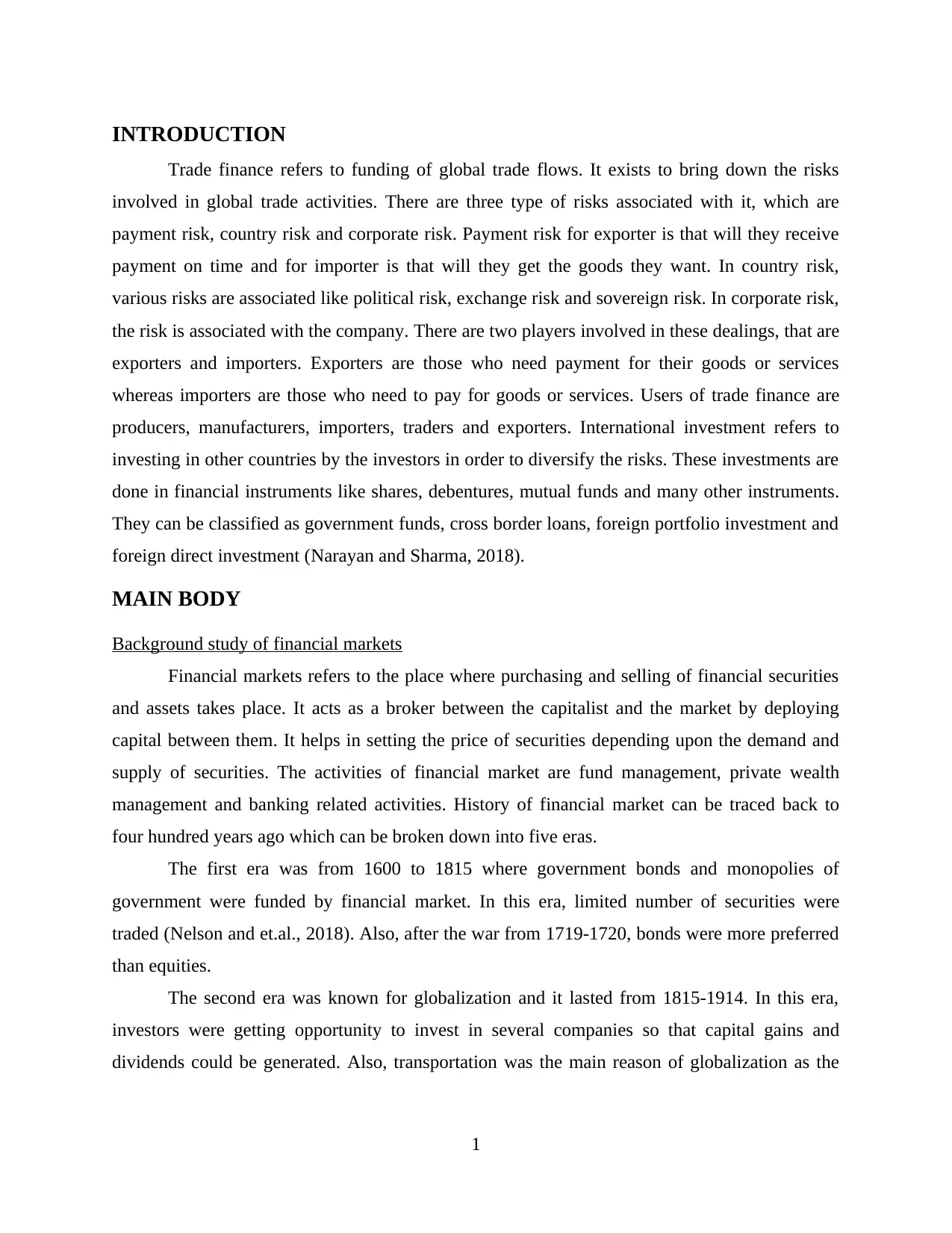
INTRODUCTION
Trade finance refers to funding of global trade flows. It exists to bring down the risks
involved in global trade activities. There are three type of risks associated with it, which are
payment risk, country risk and corporate risk. Payment risk for exporter is that will they receive
payment on time and for importer is that will they get the goods they want. In country risk,
various risks are associated like political risk, exchange risk and sovereign risk. In corporate risk,
the risk is associated with the company. There are two players involved in these dealings, that are
exporters and importers. Exporters are those who need payment for their goods or services
whereas importers are those who need to pay for goods or services. Users of trade finance are
producers, manufacturers, importers, traders and exporters. International investment refers to
investing in other countries by the investors in order to diversify the risks. These investments are
done in financial instruments like shares, debentures, mutual funds and many other instruments.
They can be classified as government funds, cross border loans, foreign portfolio investment and
foreign direct investment (Narayan and Sharma, 2018).
MAIN BODY
Background study of financial markets
Financial markets refers to the place where purchasing and selling of financial securities
and assets takes place. It acts as a broker between the capitalist and the market by deploying
capital between them. It helps in setting the price of securities depending upon the demand and
supply of securities. The activities of financial market are fund management, private wealth
management and banking related activities. History of financial market can be traced back to
four hundred years ago which can be broken down into five eras.
The first era was from 1600 to 1815 where government bonds and monopolies of
government were funded by financial market. In this era, limited number of securities were
traded (Nelson and et.al., 2018). Also, after the war from 1719-1720, bonds were more preferred
than equities.
The second era was known for globalization and it lasted from 1815-1914. In this era,
investors were getting opportunity to invest in several companies so that capital gains and
dividends could be generated. Also, transportation was the main reason of globalization as the
1
Trade finance refers to funding of global trade flows. It exists to bring down the risks
involved in global trade activities. There are three type of risks associated with it, which are
payment risk, country risk and corporate risk. Payment risk for exporter is that will they receive
payment on time and for importer is that will they get the goods they want. In country risk,
various risks are associated like political risk, exchange risk and sovereign risk. In corporate risk,
the risk is associated with the company. There are two players involved in these dealings, that are
exporters and importers. Exporters are those who need payment for their goods or services
whereas importers are those who need to pay for goods or services. Users of trade finance are
producers, manufacturers, importers, traders and exporters. International investment refers to
investing in other countries by the investors in order to diversify the risks. These investments are
done in financial instruments like shares, debentures, mutual funds and many other instruments.
They can be classified as government funds, cross border loans, foreign portfolio investment and
foreign direct investment (Narayan and Sharma, 2018).
MAIN BODY
Background study of financial markets
Financial markets refers to the place where purchasing and selling of financial securities
and assets takes place. It acts as a broker between the capitalist and the market by deploying
capital between them. It helps in setting the price of securities depending upon the demand and
supply of securities. The activities of financial market are fund management, private wealth
management and banking related activities. History of financial market can be traced back to
four hundred years ago which can be broken down into five eras.
The first era was from 1600 to 1815 where government bonds and monopolies of
government were funded by financial market. In this era, limited number of securities were
traded (Nelson and et.al., 2018). Also, after the war from 1719-1720, bonds were more preferred
than equities.
The second era was known for globalization and it lasted from 1815-1914. In this era,
investors were getting opportunity to invest in several companies so that capital gains and
dividends could be generated. Also, transportation was the main reason of globalization as the
1
⊘ This is a preview!⊘
Do you want full access?
Subscribe today to unlock all pages.

Trusted by 1+ million students worldwide
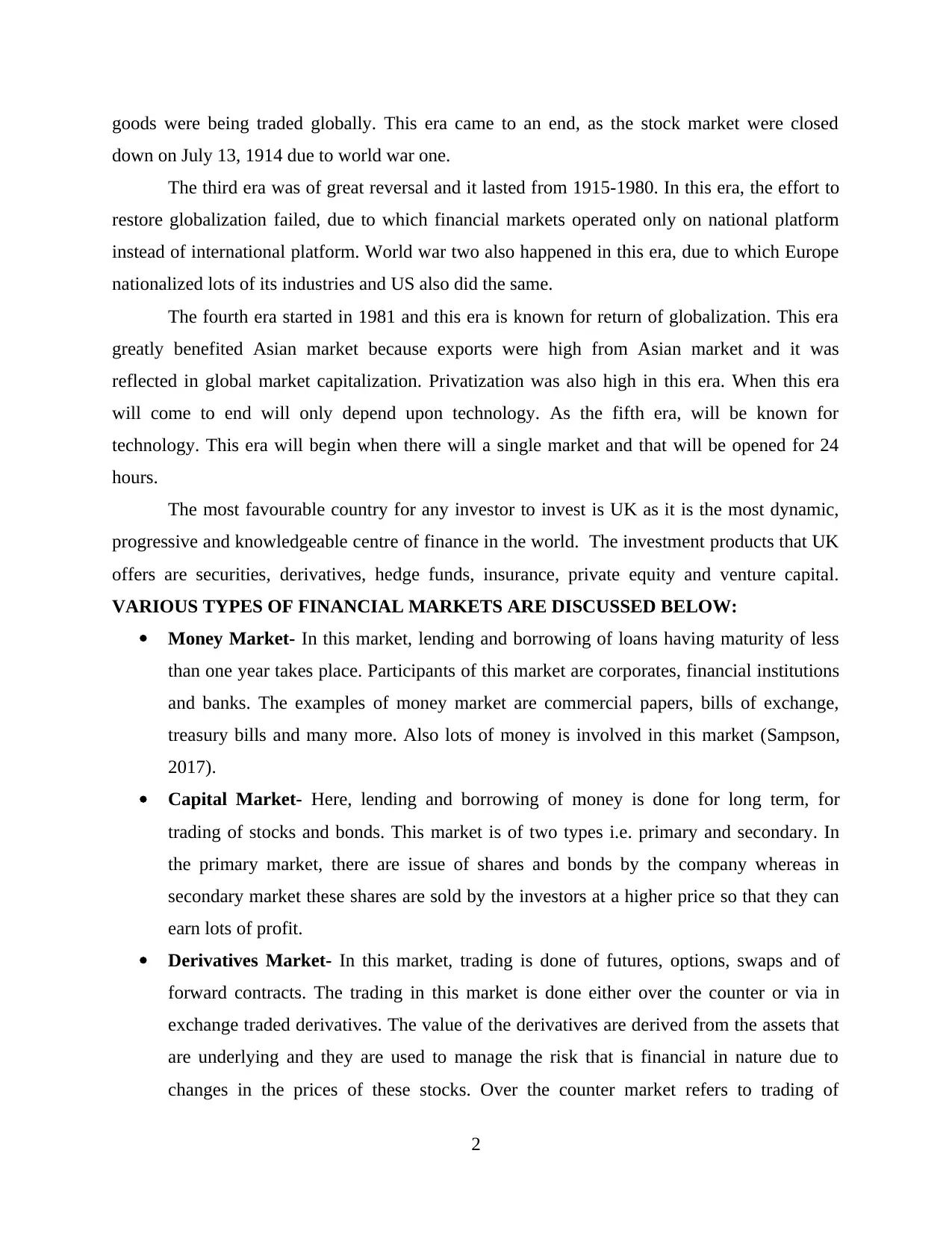
goods were being traded globally. This era came to an end, as the stock market were closed
down on July 13, 1914 due to world war one.
The third era was of great reversal and it lasted from 1915-1980. In this era, the effort to
restore globalization failed, due to which financial markets operated only on national platform
instead of international platform. World war two also happened in this era, due to which Europe
nationalized lots of its industries and US also did the same.
The fourth era started in 1981 and this era is known for return of globalization. This era
greatly benefited Asian market because exports were high from Asian market and it was
reflected in global market capitalization. Privatization was also high in this era. When this era
will come to end will only depend upon technology. As the fifth era, will be known for
technology. This era will begin when there will a single market and that will be opened for 24
hours.
The most favourable country for any investor to invest is UK as it is the most dynamic,
progressive and knowledgeable centre of finance in the world. The investment products that UK
offers are securities, derivatives, hedge funds, insurance, private equity and venture capital.
VARIOUS TYPES OF FINANCIAL MARKETS ARE DISCUSSED BELOW:
Money Market- In this market, lending and borrowing of loans having maturity of less
than one year takes place. Participants of this market are corporates, financial institutions
and banks. The examples of money market are commercial papers, bills of exchange,
treasury bills and many more. Also lots of money is involved in this market (Sampson,
2017).
Capital Market- Here, lending and borrowing of money is done for long term, for
trading of stocks and bonds. This market is of two types i.e. primary and secondary. In
the primary market, there are issue of shares and bonds by the company whereas in
secondary market these shares are sold by the investors at a higher price so that they can
earn lots of profit.
Derivatives Market- In this market, trading is done of futures, options, swaps and of
forward contracts. The trading in this market is done either over the counter or via in
exchange traded derivatives. The value of the derivatives are derived from the assets that
are underlying and they are used to manage the risk that is financial in nature due to
changes in the prices of these stocks. Over the counter market refers to trading of
2
down on July 13, 1914 due to world war one.
The third era was of great reversal and it lasted from 1915-1980. In this era, the effort to
restore globalization failed, due to which financial markets operated only on national platform
instead of international platform. World war two also happened in this era, due to which Europe
nationalized lots of its industries and US also did the same.
The fourth era started in 1981 and this era is known for return of globalization. This era
greatly benefited Asian market because exports were high from Asian market and it was
reflected in global market capitalization. Privatization was also high in this era. When this era
will come to end will only depend upon technology. As the fifth era, will be known for
technology. This era will begin when there will a single market and that will be opened for 24
hours.
The most favourable country for any investor to invest is UK as it is the most dynamic,
progressive and knowledgeable centre of finance in the world. The investment products that UK
offers are securities, derivatives, hedge funds, insurance, private equity and venture capital.
VARIOUS TYPES OF FINANCIAL MARKETS ARE DISCUSSED BELOW:
Money Market- In this market, lending and borrowing of loans having maturity of less
than one year takes place. Participants of this market are corporates, financial institutions
and banks. The examples of money market are commercial papers, bills of exchange,
treasury bills and many more. Also lots of money is involved in this market (Sampson,
2017).
Capital Market- Here, lending and borrowing of money is done for long term, for
trading of stocks and bonds. This market is of two types i.e. primary and secondary. In
the primary market, there are issue of shares and bonds by the company whereas in
secondary market these shares are sold by the investors at a higher price so that they can
earn lots of profit.
Derivatives Market- In this market, trading is done of futures, options, swaps and of
forward contracts. The trading in this market is done either over the counter or via in
exchange traded derivatives. The value of the derivatives are derived from the assets that
are underlying and they are used to manage the risk that is financial in nature due to
changes in the prices of these stocks. Over the counter market refers to trading of
2
Paraphrase This Document
Need a fresh take? Get an instant paraphrase of this document with our AI Paraphraser
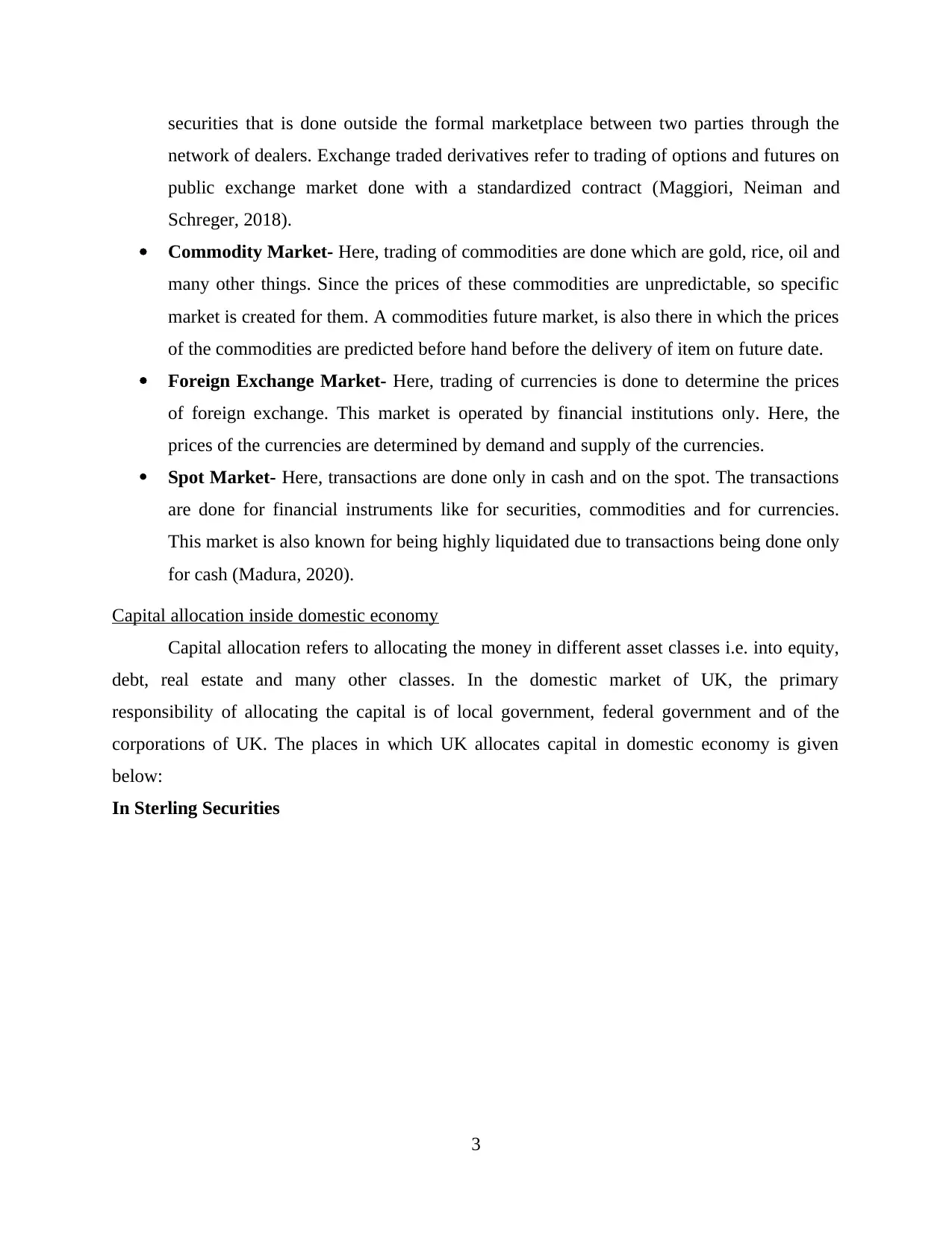
securities that is done outside the formal marketplace between two parties through the
network of dealers. Exchange traded derivatives refer to trading of options and futures on
public exchange market done with a standardized contract (Maggiori, Neiman and
Schreger, 2018).
Commodity Market- Here, trading of commodities are done which are gold, rice, oil and
many other things. Since the prices of these commodities are unpredictable, so specific
market is created for them. A commodities future market, is also there in which the prices
of the commodities are predicted before hand before the delivery of item on future date.
Foreign Exchange Market- Here, trading of currencies is done to determine the prices
of foreign exchange. This market is operated by financial institutions only. Here, the
prices of the currencies are determined by demand and supply of the currencies.
Spot Market- Here, transactions are done only in cash and on the spot. The transactions
are done for financial instruments like for securities, commodities and for currencies.
This market is also known for being highly liquidated due to transactions being done only
for cash (Madura, 2020).
Capital allocation inside domestic economy
Capital allocation refers to allocating the money in different asset classes i.e. into equity,
debt, real estate and many other classes. In the domestic market of UK, the primary
responsibility of allocating the capital is of local government, federal government and of the
corporations of UK. The places in which UK allocates capital in domestic economy is given
below:
In Sterling Securities
3
network of dealers. Exchange traded derivatives refer to trading of options and futures on
public exchange market done with a standardized contract (Maggiori, Neiman and
Schreger, 2018).
Commodity Market- Here, trading of commodities are done which are gold, rice, oil and
many other things. Since the prices of these commodities are unpredictable, so specific
market is created for them. A commodities future market, is also there in which the prices
of the commodities are predicted before hand before the delivery of item on future date.
Foreign Exchange Market- Here, trading of currencies is done to determine the prices
of foreign exchange. This market is operated by financial institutions only. Here, the
prices of the currencies are determined by demand and supply of the currencies.
Spot Market- Here, transactions are done only in cash and on the spot. The transactions
are done for financial instruments like for securities, commodities and for currencies.
This market is also known for being highly liquidated due to transactions being done only
for cash (Madura, 2020).
Capital allocation inside domestic economy
Capital allocation refers to allocating the money in different asset classes i.e. into equity,
debt, real estate and many other classes. In the domestic market of UK, the primary
responsibility of allocating the capital is of local government, federal government and of the
corporations of UK. The places in which UK allocates capital in domestic economy is given
below:
In Sterling Securities
3
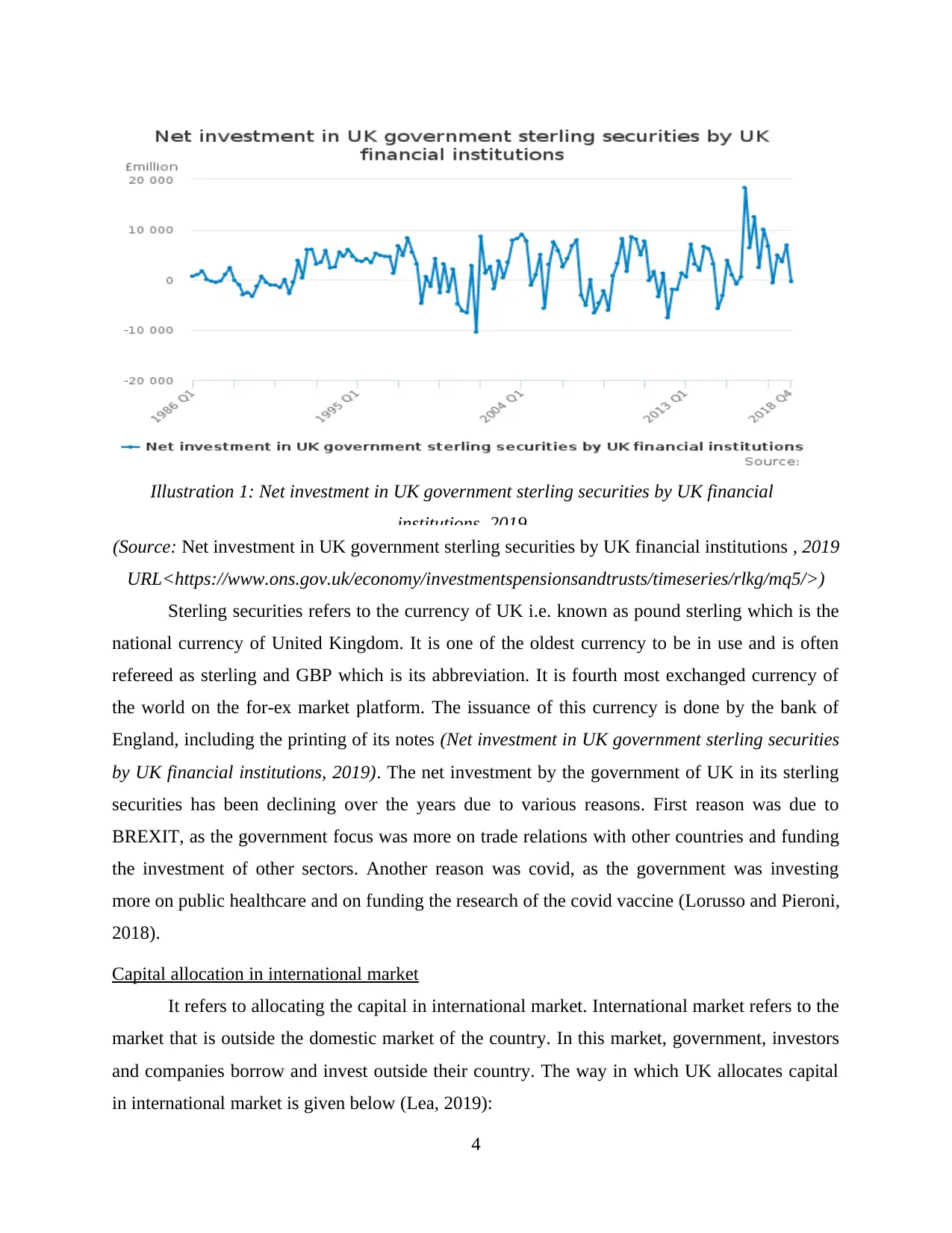
Illustration 1: Net investment in UK government sterling securities by UK financial
institutions, 2019
(Source: Net investment in UK government sterling securities by UK financial institutions , 2019
URL<https://www.ons.gov.uk/economy/investmentspensionsandtrusts/timeseries/rlkg/mq5/>)
Sterling securities refers to the currency of UK i.e. known as pound sterling which is the
national currency of United Kingdom. It is one of the oldest currency to be in use and is often
refereed as sterling and GBP which is its abbreviation. It is fourth most exchanged currency of
the world on the for-ex market platform. The issuance of this currency is done by the bank of
England, including the printing of its notes (Net investment in UK government sterling securities
by UK financial institutions, 2019). The net investment by the government of UK in its sterling
securities has been declining over the years due to various reasons. First reason was due to
BREXIT, as the government focus was more on trade relations with other countries and funding
the investment of other sectors. Another reason was covid, as the government was investing
more on public healthcare and on funding the research of the covid vaccine (Lorusso and Pieroni,
2018).
Capital allocation in international market
It refers to allocating the capital in international market. International market refers to the
market that is outside the domestic market of the country. In this market, government, investors
and companies borrow and invest outside their country. The way in which UK allocates capital
in international market is given below (Lea, 2019):
4
institutions, 2019
(Source: Net investment in UK government sterling securities by UK financial institutions , 2019
URL<https://www.ons.gov.uk/economy/investmentspensionsandtrusts/timeseries/rlkg/mq5/>)
Sterling securities refers to the currency of UK i.e. known as pound sterling which is the
national currency of United Kingdom. It is one of the oldest currency to be in use and is often
refereed as sterling and GBP which is its abbreviation. It is fourth most exchanged currency of
the world on the for-ex market platform. The issuance of this currency is done by the bank of
England, including the printing of its notes (Net investment in UK government sterling securities
by UK financial institutions, 2019). The net investment by the government of UK in its sterling
securities has been declining over the years due to various reasons. First reason was due to
BREXIT, as the government focus was more on trade relations with other countries and funding
the investment of other sectors. Another reason was covid, as the government was investing
more on public healthcare and on funding the research of the covid vaccine (Lorusso and Pieroni,
2018).
Capital allocation in international market
It refers to allocating the capital in international market. International market refers to the
market that is outside the domestic market of the country. In this market, government, investors
and companies borrow and invest outside their country. The way in which UK allocates capital
in international market is given below (Lea, 2019):
4
⊘ This is a preview!⊘
Do you want full access?
Subscribe today to unlock all pages.

Trusted by 1+ million students worldwide
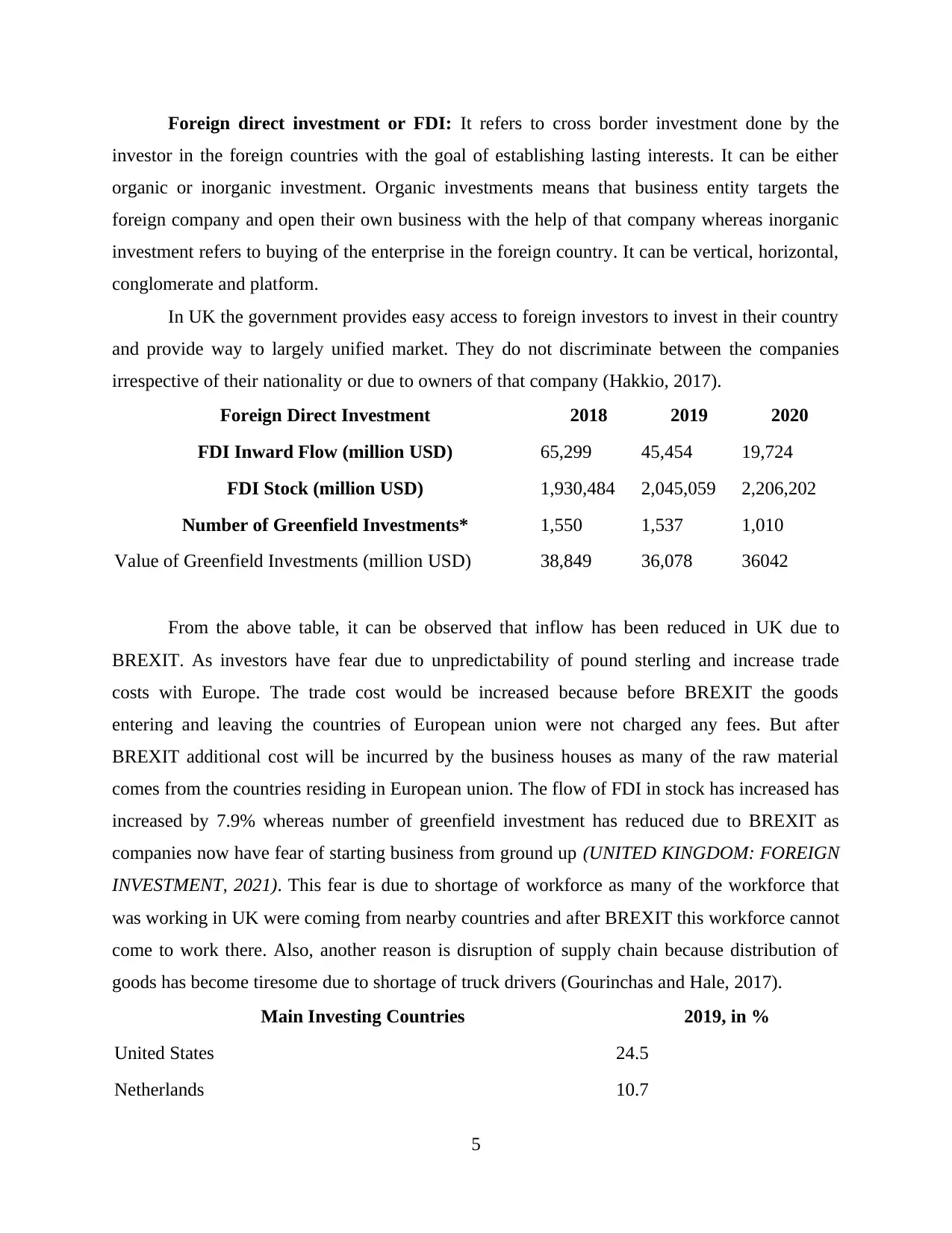
Foreign direct investment or FDI: It refers to cross border investment done by the
investor in the foreign countries with the goal of establishing lasting interests. It can be either
organic or inorganic investment. Organic investments means that business entity targets the
foreign company and open their own business with the help of that company whereas inorganic
investment refers to buying of the enterprise in the foreign country. It can be vertical, horizontal,
conglomerate and platform.
In UK the government provides easy access to foreign investors to invest in their country
and provide way to largely unified market. They do not discriminate between the companies
irrespective of their nationality or due to owners of that company (Hakkio, 2017).
Foreign Direct Investment 2018 2019 2020
FDI Inward Flow (million USD) 65,299 45,454 19,724
FDI Stock (million USD) 1,930,484 2,045,059 2,206,202
Number of Greenfield Investments* 1,550 1,537 1,010
Value of Greenfield Investments (million USD) 38,849 36,078 36042
From the above table, it can be observed that inflow has been reduced in UK due to
BREXIT. As investors have fear due to unpredictability of pound sterling and increase trade
costs with Europe. The trade cost would be increased because before BREXIT the goods
entering and leaving the countries of European union were not charged any fees. But after
BREXIT additional cost will be incurred by the business houses as many of the raw material
comes from the countries residing in European union. The flow of FDI in stock has increased has
increased by 7.9% whereas number of greenfield investment has reduced due to BREXIT as
companies now have fear of starting business from ground up (UNITED KINGDOM: FOREIGN
INVESTMENT, 2021). This fear is due to shortage of workforce as many of the workforce that
was working in UK were coming from nearby countries and after BREXIT this workforce cannot
come to work there. Also, another reason is disruption of supply chain because distribution of
goods has become tiresome due to shortage of truck drivers (Gourinchas and Hale, 2017).
Main Investing Countries 2019, in %
United States 24.5
Netherlands 10.7
5
investor in the foreign countries with the goal of establishing lasting interests. It can be either
organic or inorganic investment. Organic investments means that business entity targets the
foreign company and open their own business with the help of that company whereas inorganic
investment refers to buying of the enterprise in the foreign country. It can be vertical, horizontal,
conglomerate and platform.
In UK the government provides easy access to foreign investors to invest in their country
and provide way to largely unified market. They do not discriminate between the companies
irrespective of their nationality or due to owners of that company (Hakkio, 2017).
Foreign Direct Investment 2018 2019 2020
FDI Inward Flow (million USD) 65,299 45,454 19,724
FDI Stock (million USD) 1,930,484 2,045,059 2,206,202
Number of Greenfield Investments* 1,550 1,537 1,010
Value of Greenfield Investments (million USD) 38,849 36,078 36042
From the above table, it can be observed that inflow has been reduced in UK due to
BREXIT. As investors have fear due to unpredictability of pound sterling and increase trade
costs with Europe. The trade cost would be increased because before BREXIT the goods
entering and leaving the countries of European union were not charged any fees. But after
BREXIT additional cost will be incurred by the business houses as many of the raw material
comes from the countries residing in European union. The flow of FDI in stock has increased has
increased by 7.9% whereas number of greenfield investment has reduced due to BREXIT as
companies now have fear of starting business from ground up (UNITED KINGDOM: FOREIGN
INVESTMENT, 2021). This fear is due to shortage of workforce as many of the workforce that
was working in UK were coming from nearby countries and after BREXIT this workforce cannot
come to work there. Also, another reason is disruption of supply chain because distribution of
goods has become tiresome due to shortage of truck drivers (Gourinchas and Hale, 2017).
Main Investing Countries 2019, in %
United States 24.5
Netherlands 10.7
5
Paraphrase This Document
Need a fresh take? Get an instant paraphrase of this document with our AI Paraphraser
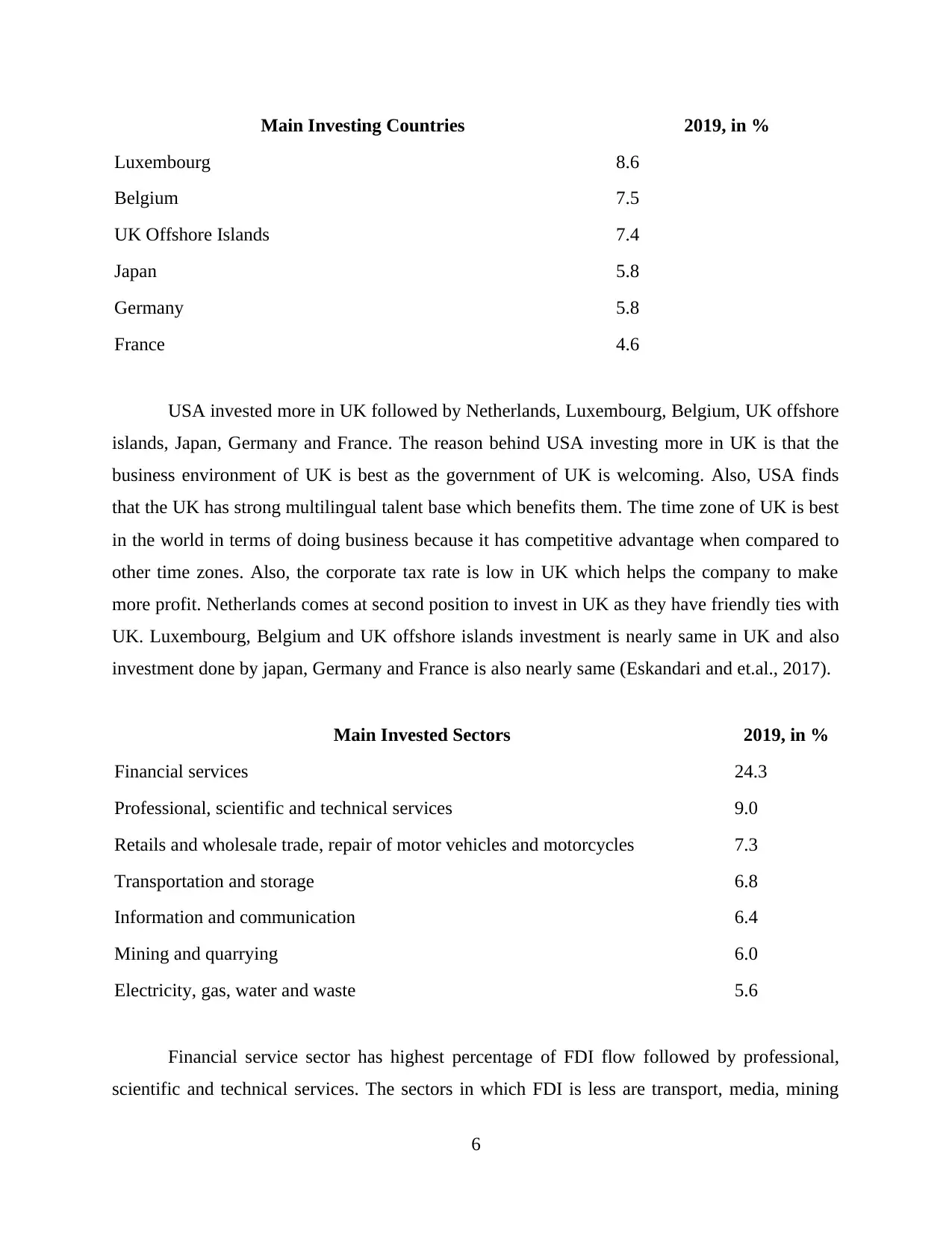
Main Investing Countries 2019, in %
Luxembourg 8.6
Belgium 7.5
UK Offshore Islands 7.4
Japan 5.8
Germany 5.8
France 4.6
USA invested more in UK followed by Netherlands, Luxembourg, Belgium, UK offshore
islands, Japan, Germany and France. The reason behind USA investing more in UK is that the
business environment of UK is best as the government of UK is welcoming. Also, USA finds
that the UK has strong multilingual talent base which benefits them. The time zone of UK is best
in the world in terms of doing business because it has competitive advantage when compared to
other time zones. Also, the corporate tax rate is low in UK which helps the company to make
more profit. Netherlands comes at second position to invest in UK as they have friendly ties with
UK. Luxembourg, Belgium and UK offshore islands investment is nearly same in UK and also
investment done by japan, Germany and France is also nearly same (Eskandari and et.al., 2017).
Main Invested Sectors 2019, in %
Financial services 24.3
Professional, scientific and technical services 9.0
Retails and wholesale trade, repair of motor vehicles and motorcycles 7.3
Transportation and storage 6.8
Information and communication 6.4
Mining and quarrying 6.0
Electricity, gas, water and waste 5.6
Financial service sector has highest percentage of FDI flow followed by professional,
scientific and technical services. The sectors in which FDI is less are transport, media, mining
6
Luxembourg 8.6
Belgium 7.5
UK Offshore Islands 7.4
Japan 5.8
Germany 5.8
France 4.6
USA invested more in UK followed by Netherlands, Luxembourg, Belgium, UK offshore
islands, Japan, Germany and France. The reason behind USA investing more in UK is that the
business environment of UK is best as the government of UK is welcoming. Also, USA finds
that the UK has strong multilingual talent base which benefits them. The time zone of UK is best
in the world in terms of doing business because it has competitive advantage when compared to
other time zones. Also, the corporate tax rate is low in UK which helps the company to make
more profit. Netherlands comes at second position to invest in UK as they have friendly ties with
UK. Luxembourg, Belgium and UK offshore islands investment is nearly same in UK and also
investment done by japan, Germany and France is also nearly same (Eskandari and et.al., 2017).
Main Invested Sectors 2019, in %
Financial services 24.3
Professional, scientific and technical services 9.0
Retails and wholesale trade, repair of motor vehicles and motorcycles 7.3
Transportation and storage 6.8
Information and communication 6.4
Mining and quarrying 6.0
Electricity, gas, water and waste 5.6
Financial service sector has highest percentage of FDI flow followed by professional,
scientific and technical services. The sectors in which FDI is less are transport, media, mining
6
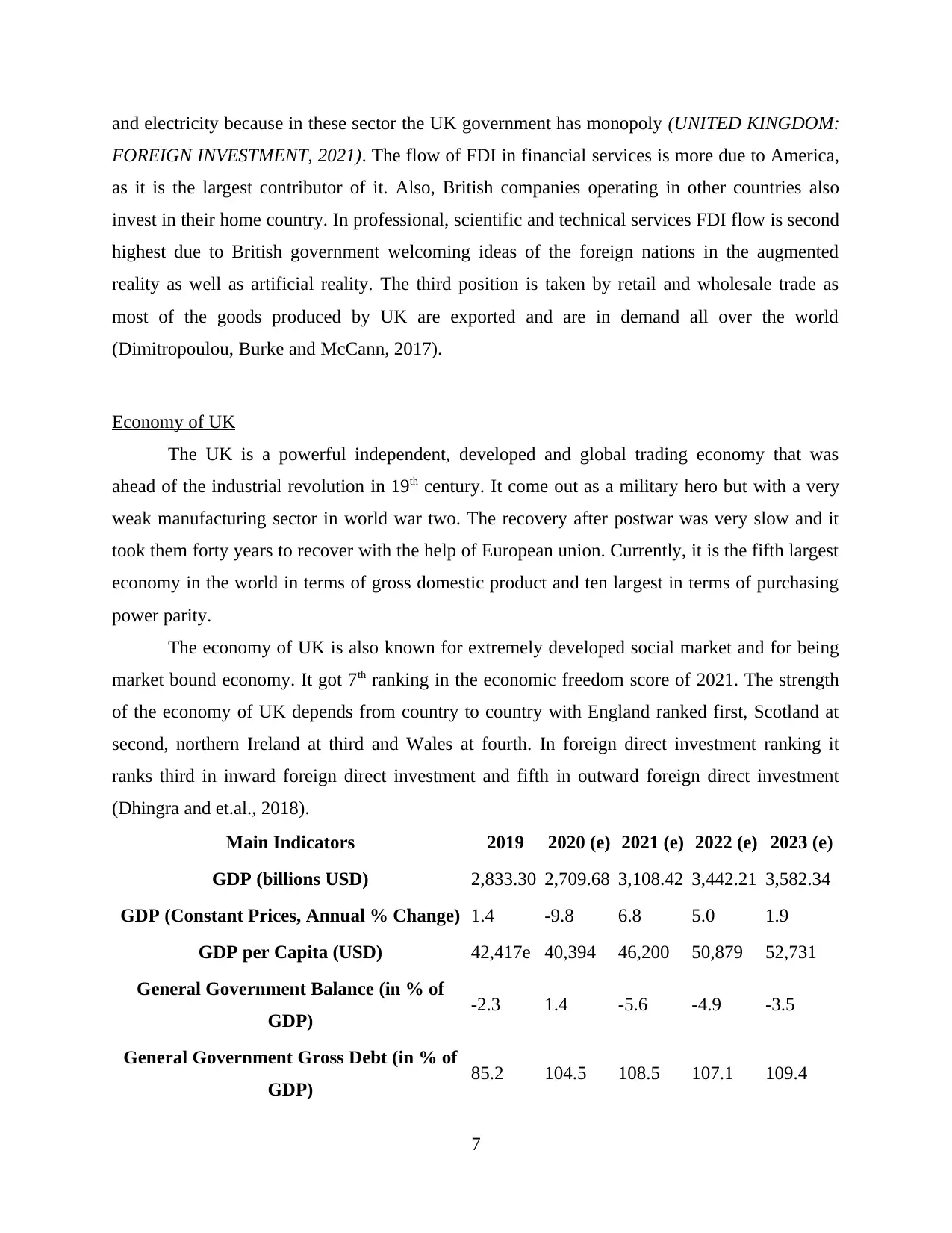
and electricity because in these sector the UK government has monopoly (UNITED KINGDOM:
FOREIGN INVESTMENT, 2021). The flow of FDI in financial services is more due to America,
as it is the largest contributor of it. Also, British companies operating in other countries also
invest in their home country. In professional, scientific and technical services FDI flow is second
highest due to British government welcoming ideas of the foreign nations in the augmented
reality as well as artificial reality. The third position is taken by retail and wholesale trade as
most of the goods produced by UK are exported and are in demand all over the world
(Dimitropoulou, Burke and McCann, 2017).
Economy of UK
The UK is a powerful independent, developed and global trading economy that was
ahead of the industrial revolution in 19th century. It come out as a military hero but with a very
weak manufacturing sector in world war two. The recovery after postwar was very slow and it
took them forty years to recover with the help of European union. Currently, it is the fifth largest
economy in the world in terms of gross domestic product and ten largest in terms of purchasing
power parity.
The economy of UK is also known for extremely developed social market and for being
market bound economy. It got 7th ranking in the economic freedom score of 2021. The strength
of the economy of UK depends from country to country with England ranked first, Scotland at
second, northern Ireland at third and Wales at fourth. In foreign direct investment ranking it
ranks third in inward foreign direct investment and fifth in outward foreign direct investment
(Dhingra and et.al., 2018).
Main Indicators 2019 2020 (e) 2021 (e) 2022 (e) 2023 (e)
GDP (billions USD) 2,833.30 2,709.68 3,108.42 3,442.21 3,582.34
GDP (Constant Prices, Annual % Change) 1.4 -9.8 6.8 5.0 1.9
GDP per Capita (USD) 42,417e 40,394 46,200 50,879 52,731
General Government Balance (in % of
GDP) -2.3 1.4 -5.6 -4.9 -3.5
General Government Gross Debt (in % of
GDP) 85.2 104.5 108.5 107.1 109.4
7
FOREIGN INVESTMENT, 2021). The flow of FDI in financial services is more due to America,
as it is the largest contributor of it. Also, British companies operating in other countries also
invest in their home country. In professional, scientific and technical services FDI flow is second
highest due to British government welcoming ideas of the foreign nations in the augmented
reality as well as artificial reality. The third position is taken by retail and wholesale trade as
most of the goods produced by UK are exported and are in demand all over the world
(Dimitropoulou, Burke and McCann, 2017).
Economy of UK
The UK is a powerful independent, developed and global trading economy that was
ahead of the industrial revolution in 19th century. It come out as a military hero but with a very
weak manufacturing sector in world war two. The recovery after postwar was very slow and it
took them forty years to recover with the help of European union. Currently, it is the fifth largest
economy in the world in terms of gross domestic product and ten largest in terms of purchasing
power parity.
The economy of UK is also known for extremely developed social market and for being
market bound economy. It got 7th ranking in the economic freedom score of 2021. The strength
of the economy of UK depends from country to country with England ranked first, Scotland at
second, northern Ireland at third and Wales at fourth. In foreign direct investment ranking it
ranks third in inward foreign direct investment and fifth in outward foreign direct investment
(Dhingra and et.al., 2018).
Main Indicators 2019 2020 (e) 2021 (e) 2022 (e) 2023 (e)
GDP (billions USD) 2,833.30 2,709.68 3,108.42 3,442.21 3,582.34
GDP (Constant Prices, Annual % Change) 1.4 -9.8 6.8 5.0 1.9
GDP per Capita (USD) 42,417e 40,394 46,200 50,879 52,731
General Government Balance (in % of
GDP) -2.3 1.4 -5.6 -4.9 -3.5
General Government Gross Debt (in % of
GDP) 85.2 104.5 108.5 107.1 109.4
7
⊘ This is a preview!⊘
Do you want full access?
Subscribe today to unlock all pages.

Trusted by 1+ million students worldwide
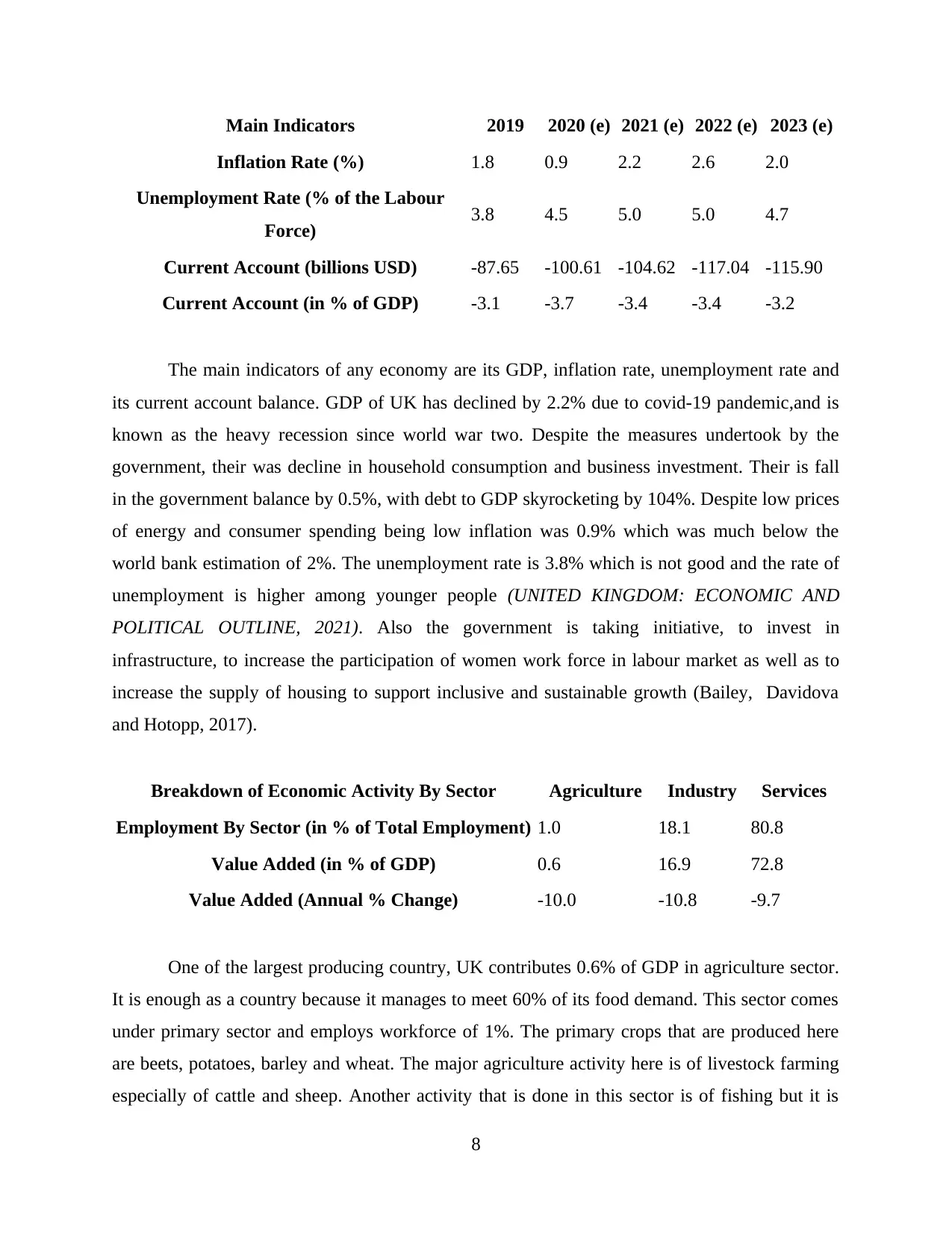
Main Indicators 2019 2020 (e) 2021 (e) 2022 (e) 2023 (e)
Inflation Rate (%) 1.8 0.9 2.2 2.6 2.0
Unemployment Rate (% of the Labour
Force) 3.8 4.5 5.0 5.0 4.7
Current Account (billions USD) -87.65 -100.61 -104.62 -117.04 -115.90
Current Account (in % of GDP) -3.1 -3.7 -3.4 -3.4 -3.2
The main indicators of any economy are its GDP, inflation rate, unemployment rate and
its current account balance. GDP of UK has declined by 2.2% due to covid-19 pandemic,and is
known as the heavy recession since world war two. Despite the measures undertook by the
government, their was decline in household consumption and business investment. Their is fall
in the government balance by 0.5%, with debt to GDP skyrocketing by 104%. Despite low prices
of energy and consumer spending being low inflation was 0.9% which was much below the
world bank estimation of 2%. The unemployment rate is 3.8% which is not good and the rate of
unemployment is higher among younger people (UNITED KINGDOM: ECONOMIC AND
POLITICAL OUTLINE, 2021). Also the government is taking initiative, to invest in
infrastructure, to increase the participation of women work force in labour market as well as to
increase the supply of housing to support inclusive and sustainable growth (Bailey, Davidova
and Hotopp, 2017).
Breakdown of Economic Activity By Sector Agriculture Industry Services
Employment By Sector (in % of Total Employment) 1.0 18.1 80.8
Value Added (in % of GDP) 0.6 16.9 72.8
Value Added (Annual % Change) -10.0 -10.8 -9.7
One of the largest producing country, UK contributes 0.6% of GDP in agriculture sector.
It is enough as a country because it manages to meet 60% of its food demand. This sector comes
under primary sector and employs workforce of 1%. The primary crops that are produced here
are beets, potatoes, barley and wheat. The major agriculture activity here is of livestock farming
especially of cattle and sheep. Another activity that is done in this sector is of fishing but it is
8
Inflation Rate (%) 1.8 0.9 2.2 2.6 2.0
Unemployment Rate (% of the Labour
Force) 3.8 4.5 5.0 5.0 4.7
Current Account (billions USD) -87.65 -100.61 -104.62 -117.04 -115.90
Current Account (in % of GDP) -3.1 -3.7 -3.4 -3.4 -3.2
The main indicators of any economy are its GDP, inflation rate, unemployment rate and
its current account balance. GDP of UK has declined by 2.2% due to covid-19 pandemic,and is
known as the heavy recession since world war two. Despite the measures undertook by the
government, their was decline in household consumption and business investment. Their is fall
in the government balance by 0.5%, with debt to GDP skyrocketing by 104%. Despite low prices
of energy and consumer spending being low inflation was 0.9% which was much below the
world bank estimation of 2%. The unemployment rate is 3.8% which is not good and the rate of
unemployment is higher among younger people (UNITED KINGDOM: ECONOMIC AND
POLITICAL OUTLINE, 2021). Also the government is taking initiative, to invest in
infrastructure, to increase the participation of women work force in labour market as well as to
increase the supply of housing to support inclusive and sustainable growth (Bailey, Davidova
and Hotopp, 2017).
Breakdown of Economic Activity By Sector Agriculture Industry Services
Employment By Sector (in % of Total Employment) 1.0 18.1 80.8
Value Added (in % of GDP) 0.6 16.9 72.8
Value Added (Annual % Change) -10.0 -10.8 -9.7
One of the largest producing country, UK contributes 0.6% of GDP in agriculture sector.
It is enough as a country because it manages to meet 60% of its food demand. This sector comes
under primary sector and employs workforce of 1%. The primary crops that are produced here
are beets, potatoes, barley and wheat. The major agriculture activity here is of livestock farming
especially of cattle and sheep. Another activity that is done in this sector is of fishing but it is
8
Paraphrase This Document
Need a fresh take? Get an instant paraphrase of this document with our AI Paraphraser
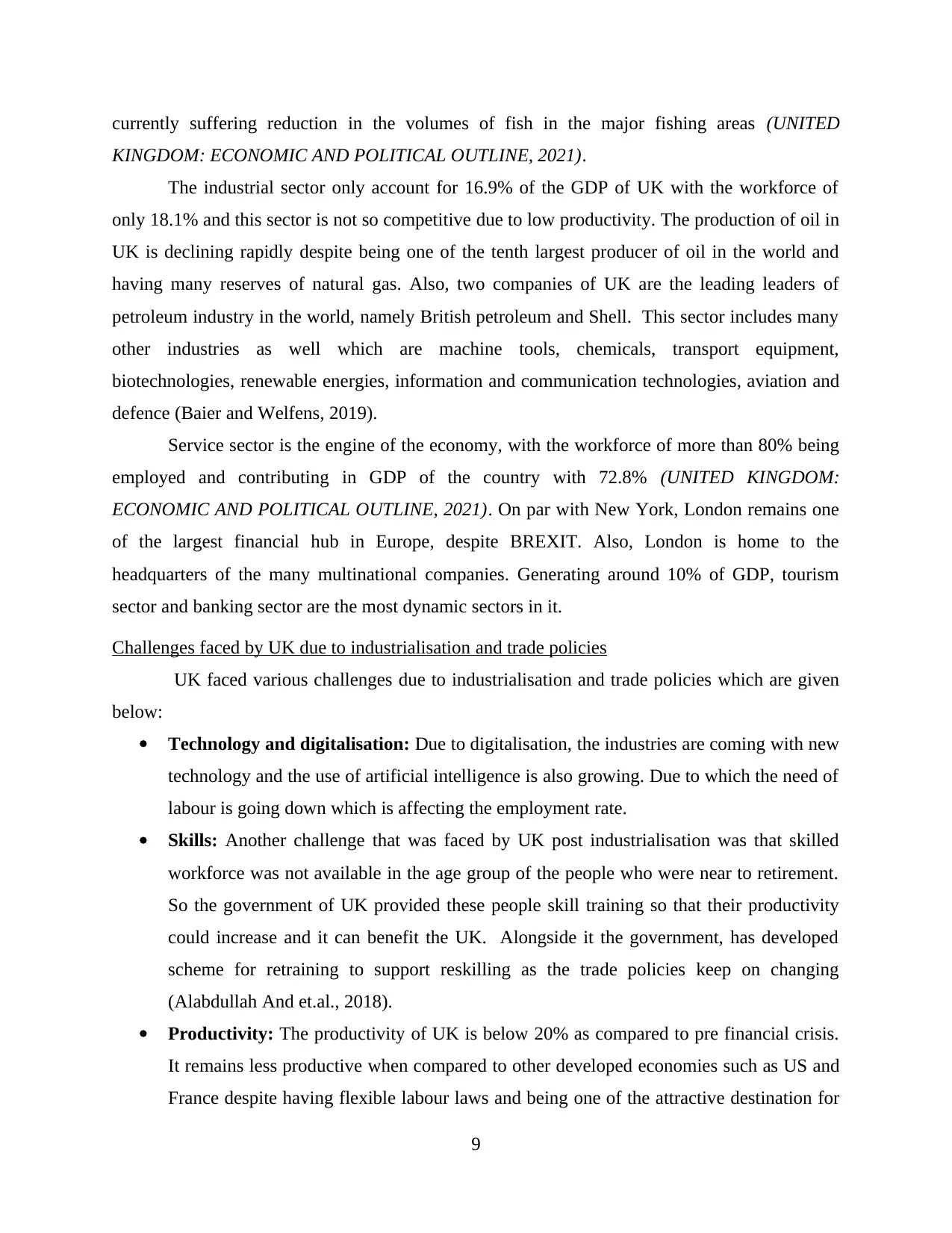
currently suffering reduction in the volumes of fish in the major fishing areas (UNITED
KINGDOM: ECONOMIC AND POLITICAL OUTLINE, 2021).
The industrial sector only account for 16.9% of the GDP of UK with the workforce of
only 18.1% and this sector is not so competitive due to low productivity. The production of oil in
UK is declining rapidly despite being one of the tenth largest producer of oil in the world and
having many reserves of natural gas. Also, two companies of UK are the leading leaders of
petroleum industry in the world, namely British petroleum and Shell. This sector includes many
other industries as well which are machine tools, chemicals, transport equipment,
biotechnologies, renewable energies, information and communication technologies, aviation and
defence (Baier and Welfens, 2019).
Service sector is the engine of the economy, with the workforce of more than 80% being
employed and contributing in GDP of the country with 72.8% (UNITED KINGDOM:
ECONOMIC AND POLITICAL OUTLINE, 2021). On par with New York, London remains one
of the largest financial hub in Europe, despite BREXIT. Also, London is home to the
headquarters of the many multinational companies. Generating around 10% of GDP, tourism
sector and banking sector are the most dynamic sectors in it.
Challenges faced by UK due to industrialisation and trade policies
UK faced various challenges due to industrialisation and trade policies which are given
below:
Technology and digitalisation: Due to digitalisation, the industries are coming with new
technology and the use of artificial intelligence is also growing. Due to which the need of
labour is going down which is affecting the employment rate.
Skills: Another challenge that was faced by UK post industrialisation was that skilled
workforce was not available in the age group of the people who were near to retirement.
So the government of UK provided these people skill training so that their productivity
could increase and it can benefit the UK. Alongside it the government, has developed
scheme for retraining to support reskilling as the trade policies keep on changing
(Alabdullah And et.al., 2018).
Productivity: The productivity of UK is below 20% as compared to pre financial crisis.
It remains less productive when compared to other developed economies such as US and
France despite having flexible labour laws and being one of the attractive destination for
9
KINGDOM: ECONOMIC AND POLITICAL OUTLINE, 2021).
The industrial sector only account for 16.9% of the GDP of UK with the workforce of
only 18.1% and this sector is not so competitive due to low productivity. The production of oil in
UK is declining rapidly despite being one of the tenth largest producer of oil in the world and
having many reserves of natural gas. Also, two companies of UK are the leading leaders of
petroleum industry in the world, namely British petroleum and Shell. This sector includes many
other industries as well which are machine tools, chemicals, transport equipment,
biotechnologies, renewable energies, information and communication technologies, aviation and
defence (Baier and Welfens, 2019).
Service sector is the engine of the economy, with the workforce of more than 80% being
employed and contributing in GDP of the country with 72.8% (UNITED KINGDOM:
ECONOMIC AND POLITICAL OUTLINE, 2021). On par with New York, London remains one
of the largest financial hub in Europe, despite BREXIT. Also, London is home to the
headquarters of the many multinational companies. Generating around 10% of GDP, tourism
sector and banking sector are the most dynamic sectors in it.
Challenges faced by UK due to industrialisation and trade policies
UK faced various challenges due to industrialisation and trade policies which are given
below:
Technology and digitalisation: Due to digitalisation, the industries are coming with new
technology and the use of artificial intelligence is also growing. Due to which the need of
labour is going down which is affecting the employment rate.
Skills: Another challenge that was faced by UK post industrialisation was that skilled
workforce was not available in the age group of the people who were near to retirement.
So the government of UK provided these people skill training so that their productivity
could increase and it can benefit the UK. Alongside it the government, has developed
scheme for retraining to support reskilling as the trade policies keep on changing
(Alabdullah And et.al., 2018).
Productivity: The productivity of UK is below 20% as compared to pre financial crisis.
It remains less productive when compared to other developed economies such as US and
France despite having flexible labour laws and being one of the attractive destination for
9
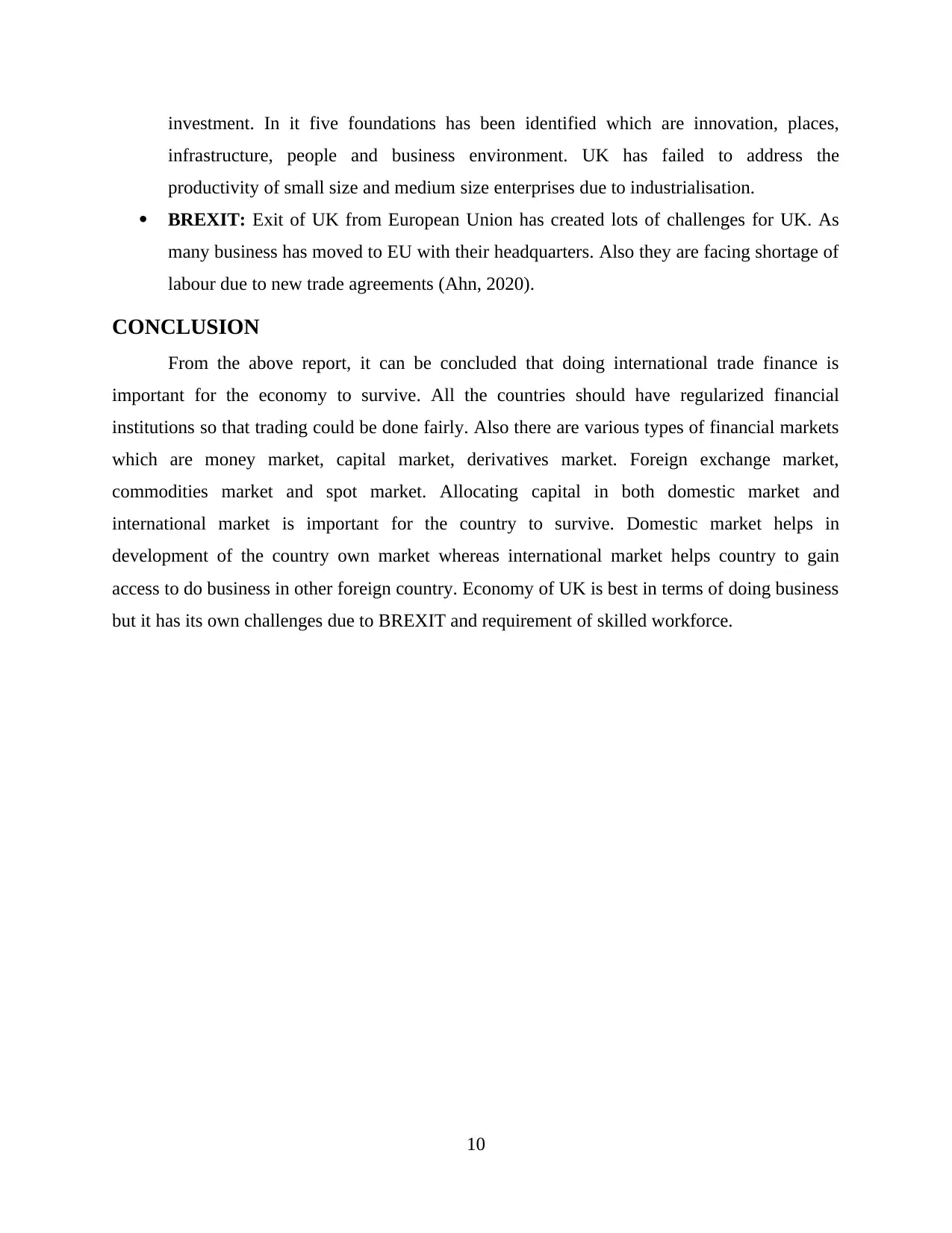
investment. In it five foundations has been identified which are innovation, places,
infrastructure, people and business environment. UK has failed to address the
productivity of small size and medium size enterprises due to industrialisation.
BREXIT: Exit of UK from European Union has created lots of challenges for UK. As
many business has moved to EU with their headquarters. Also they are facing shortage of
labour due to new trade agreements (Ahn, 2020).
CONCLUSION
From the above report, it can be concluded that doing international trade finance is
important for the economy to survive. All the countries should have regularized financial
institutions so that trading could be done fairly. Also there are various types of financial markets
which are money market, capital market, derivatives market. Foreign exchange market,
commodities market and spot market. Allocating capital in both domestic market and
international market is important for the country to survive. Domestic market helps in
development of the country own market whereas international market helps country to gain
access to do business in other foreign country. Economy of UK is best in terms of doing business
but it has its own challenges due to BREXIT and requirement of skilled workforce.
10
infrastructure, people and business environment. UK has failed to address the
productivity of small size and medium size enterprises due to industrialisation.
BREXIT: Exit of UK from European Union has created lots of challenges for UK. As
many business has moved to EU with their headquarters. Also they are facing shortage of
labour due to new trade agreements (Ahn, 2020).
CONCLUSION
From the above report, it can be concluded that doing international trade finance is
important for the economy to survive. All the countries should have regularized financial
institutions so that trading could be done fairly. Also there are various types of financial markets
which are money market, capital market, derivatives market. Foreign exchange market,
commodities market and spot market. Allocating capital in both domestic market and
international market is important for the country to survive. Domestic market helps in
development of the country own market whereas international market helps country to gain
access to do business in other foreign country. Economy of UK is best in terms of doing business
but it has its own challenges due to BREXIT and requirement of skilled workforce.
10
⊘ This is a preview!⊘
Do you want full access?
Subscribe today to unlock all pages.

Trusted by 1+ million students worldwide
1 out of 13
Related Documents
Your All-in-One AI-Powered Toolkit for Academic Success.
+13062052269
info@desklib.com
Available 24*7 on WhatsApp / Email
![[object Object]](/_next/static/media/star-bottom.7253800d.svg)
Unlock your academic potential
Copyright © 2020–2025 A2Z Services. All Rights Reserved. Developed and managed by ZUCOL.




